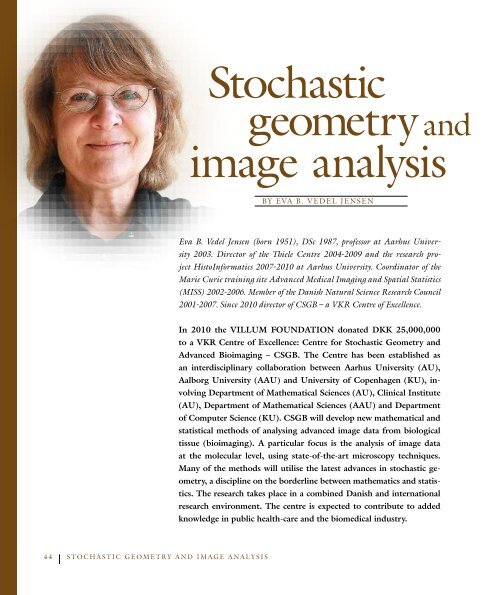Home to the skylark - The Velux Foundations
Home to the skylark - The Velux Foundations
Home to the skylark - The Velux Foundations
You also want an ePaper? Increase the reach of your titles
YUMPU automatically turns print PDFs into web optimized ePapers that Google loves.
S<strong>to</strong>chastic<br />
geometry and<br />
image analysis<br />
BY EVA B. VEDEL JENSEN<br />
Eva B. Vedel Jensen (born 1951), DSc 1987, professor at Aarhus Univer-<br />
sity 2003. Direc<strong>to</strong>r of <strong>the</strong> Thiele Centre 2004-2009 and <strong>the</strong> research pro-<br />
ject His<strong>to</strong> Informatics 2007-2010 at Aarhus University. Coordina<strong>to</strong>r of <strong>the</strong><br />
Marie Curie training site Advanced Medical Imaging and Spatial Statistics<br />
(MISS) 2002-2006. Member of <strong>the</strong> Danish Natural Science Research Council<br />
2001-2007. Since 2010 direc<strong>to</strong>r of CSGB – a VKR Centre of Excellence.<br />
In 2010 <strong>the</strong> VILLUM FOUNDATION donated DKK 25,000,000<br />
<strong>to</strong> a VKR Centre of Excellence: Centre for S<strong>to</strong>chastic Geometry and<br />
Advanced Bioimaging – CSGB. <strong>The</strong> Centre has been established as<br />
an interdisciplinary collaboration between Aarhus University (AU),<br />
Aalborg University (AAU) and University of Copenhagen (KU), in-<br />
volving Department of Ma<strong>the</strong>matical Sciences (AU), Clinical Institute<br />
(AU), Department of Ma<strong>the</strong>matical Sciences (AAU) and Department<br />
of Computer Science (KU). CSGB will develop new ma<strong>the</strong>matical and<br />
statistical methods of analysing advanced image data from biological<br />
tissue (bioimaging). A particular focus is <strong>the</strong> analysis of image data<br />
at <strong>the</strong> molecular level, using state-of-<strong>the</strong>-art microscopy techniques.<br />
Many of <strong>the</strong> methods will utilise <strong>the</strong> latest advances in s<strong>to</strong>chastic ge-<br />
ometry, a discipline on <strong>the</strong> borderline between ma<strong>the</strong>matics and statis-<br />
tics. <strong>The</strong> research takes place in a combined Danish and international<br />
research environment. <strong>The</strong> centre is expected <strong>to</strong> contribute <strong>to</strong> added<br />
knowledge in public health-care and <strong>the</strong> biomedical industry.<br />
Ma<strong>the</strong>matics and statistics play a key role in <strong>the</strong> biosciences. Dur-<br />
ing <strong>the</strong> last 25 years ma<strong>the</strong>matical and statistical models have been<br />
developed for <strong>the</strong> analysis of cell populations, based on data from<br />
traditional light microscopy. With <strong>the</strong> development of, e.g., laser<br />
scanning and so-called cryo-electron microscopy it is, however,<br />
now possible <strong>to</strong> acquire images of biological tissue (bioimaging)<br />
at <strong>the</strong> molecular level and this requires a corresponding develop-<br />
ment of ma<strong>the</strong>matical and statistical methods.<br />
S<strong>to</strong>chastic geometry<br />
S<strong>to</strong>chastic geometry is an important prerequisite for this develop-<br />
ment of methods. S<strong>to</strong>chastic geometry is used in modelling and<br />
analysis of spatial structures such as curves and surfaces. Stereology<br />
is an important subfield of s<strong>to</strong>chastic geometry. As <strong>the</strong> name indi-<br />
cates, stereology provides information about a spatial structure<br />
(three dimensions) from a number of sections (two di-<br />
mensions) through <strong>the</strong> structure (see fig. 1).<br />
One of <strong>the</strong> principal contributions of s<strong>to</strong>chastic<br />
geometry is a number of geometric calcu-<br />
lation formulae (functionals) <strong>to</strong> describe <strong>the</strong><br />
quantitative properties of a spatial structure, for in-<br />
stance, volume, surface area, length, number and curva-<br />
ture. <strong>The</strong>se functionals have been used in numerous stereo-<br />
logical studies of biological tissue at <strong>the</strong> light microscopy level.<br />
Local stereology<br />
In s<strong>to</strong>chastic geometry, <strong>the</strong>re has recently been a lot of focus on <strong>the</strong><br />
study of a number of new functionals, so-called volume and surface<br />
tensors, that are, so <strong>to</strong> speak, able <strong>to</strong> ‘zoom in’ and provide more<br />
detailed local information about a spatial structure than <strong>the</strong> more<br />
general global information in <strong>the</strong> previous functionals. At <strong>the</strong> cen-<br />
tre we want <strong>to</strong> utilise <strong>the</strong>se advances in enhancing analysis of image<br />
data from biological tissue.<br />
For example, earlier stereological analyses of <strong>the</strong> cerebral cortex<br />
in humans with dementia or schizophrenia do not show changes<br />
in <strong>the</strong> <strong>to</strong>tal number of neurons. We expect that <strong>the</strong>re are instead<br />
changes in <strong>the</strong> spatial arrangement of neurons in certain regions<br />
of <strong>the</strong> cortex. Likewise, disease-caused changes in tissue do not<br />
Fig.1. Local stereology makes it possible<br />
<strong>to</strong> calculate estimates of parameters<br />
of a spatial structure, such as volume<br />
and surface area, from observations<br />
along lines or in planes passing<br />
through a reference point. At CSGB,<br />
local stereological methods of determining<br />
so-called volume and surface<br />
tensors are developed. <strong>The</strong>se tensors<br />
can provide new information about<br />
shape and orientation distributions in<br />
cell populations. Illustration: Markus<br />
Kiderlen<br />
44 STOCHASTIC GEOMETRY AND IMAGE ANALYSIS VILLUM FOUNDATION 45<br />
TECHNICAL AND NATURAL SCIENCES



